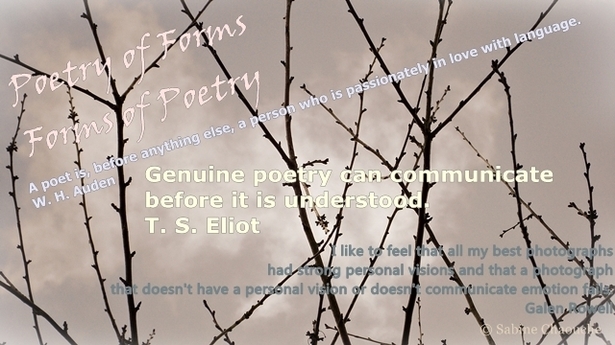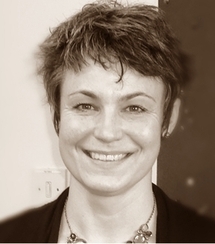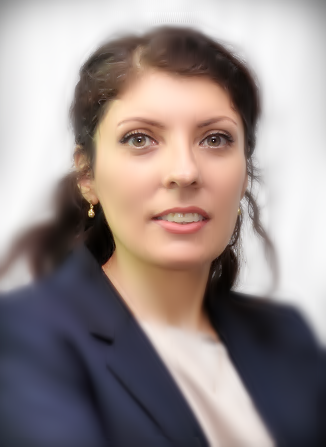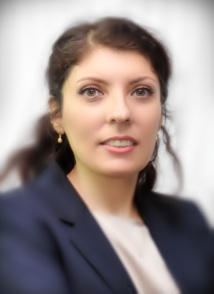
(c) Sabine Chaouche - Cours les Barres (France) 2011
What is the essence of Poetry and what are its forms?
The Tower of Babel myth, from biblical accounts, reminds us that the world is made of signs and multiple forms of language. God punished men by confounding the languages of all the Earth. Over the centuries, poetry, ‘Language of Gods’, appeared to be a unique form to transcend division by creating a universal language of its own, through specific forms: such as the sonnet for instance, or specific rhythms and sonorities (alexandrine, rhyme homophony, syllabics etc.). Poetry was often compared to the music of the soul.
In the sixteenth century, Poetry was associated with the ‘apollonian furor’ (the poet being inspired by Apollo, God of Poetry) or later, to the Dionysian trance - hence Shaftesbury’s theories on enthusiasm. The Renaissance period also emphasised the interdependence between Text and Image. Horatio’s Ut pictura poesis (‘Poetry is similar to a Painting’) impacted strongly on European Literature during the period. Painting emotions or scenes through language (Hypotyposes) and visualizing Art (Ekphrasis) were common figures of speech. Most of the works published in the early modern period were therefore based on Poetry - which became a must in any piece of writing – and Art. Lyricism and expressiveness became predominant in the c19 with a literary movement such as Romanticism. At the end of the century Symbolism revolutionised poetic forms using synaesthesia, analogy, and free verse, and exploring themes such as the sacred, the secret, and the musical.
As Poetry, Images are a form of universal language made of signs. In his work Concerning Spiritualism in Art, Kandinsky stressed the power of points, lines and colours, coming from an ‘inner necessity’ and creating an ‘inner resonance’ in the spectator. He theorized abstract painting and its emotional effect ‘by the expressive power of linear forms. Lyricism is the pathos of a force whose triumphant effort enters into action and encounters no obstacle. Because the straight line results from the initiative of a single, unopposed force, its domain is that of the lyric. When two forces are present and thus enter in conflict, as this is the case with the curve or the zigzag line, we are in domain of drama’ (Michel Henry, Seeing the invisible, on Kandinsky, 11). Painting, as well as words, has its own tonalities and genres.
This exhibition does not raise the question of the mimèsis, i.e. the imitation of the urban or natural environment: the photographs do not intend to capture reality but to produce new art forms (‘digitised paintings’) from real elements taken from our world such as urban landscapes. The aim is to recreate an abstract piece of art from nature’s own sublime language or from artificial elements; to form an image where line, colours and points, feminine and masculine combine to create a Poetic space. The poems intend to trace an inner experience, Beauty and Emotion captured in the eyes of the beholder. By translating and transposing the emotional charge transmitted by the images into a metaphoric language, they create other images, illuminating the constant dialectic between the Poetry of forms and the forms of Poetry.
Sabine Chaouche
Photographer
19-04-2012
The Tower of Babel myth, from biblical accounts, reminds us that the world is made of signs and multiple forms of language. God punished men by confounding the languages of all the Earth. Over the centuries, poetry, ‘Language of Gods’, appeared to be a unique form to transcend division by creating a universal language of its own, through specific forms: such as the sonnet for instance, or specific rhythms and sonorities (alexandrine, rhyme homophony, syllabics etc.). Poetry was often compared to the music of the soul.
In the sixteenth century, Poetry was associated with the ‘apollonian furor’ (the poet being inspired by Apollo, God of Poetry) or later, to the Dionysian trance - hence Shaftesbury’s theories on enthusiasm. The Renaissance period also emphasised the interdependence between Text and Image. Horatio’s Ut pictura poesis (‘Poetry is similar to a Painting’) impacted strongly on European Literature during the period. Painting emotions or scenes through language (Hypotyposes) and visualizing Art (Ekphrasis) were common figures of speech. Most of the works published in the early modern period were therefore based on Poetry - which became a must in any piece of writing – and Art. Lyricism and expressiveness became predominant in the c19 with a literary movement such as Romanticism. At the end of the century Symbolism revolutionised poetic forms using synaesthesia, analogy, and free verse, and exploring themes such as the sacred, the secret, and the musical.
As Poetry, Images are a form of universal language made of signs. In his work Concerning Spiritualism in Art, Kandinsky stressed the power of points, lines and colours, coming from an ‘inner necessity’ and creating an ‘inner resonance’ in the spectator. He theorized abstract painting and its emotional effect ‘by the expressive power of linear forms. Lyricism is the pathos of a force whose triumphant effort enters into action and encounters no obstacle. Because the straight line results from the initiative of a single, unopposed force, its domain is that of the lyric. When two forces are present and thus enter in conflict, as this is the case with the curve or the zigzag line, we are in domain of drama’ (Michel Henry, Seeing the invisible, on Kandinsky, 11). Painting, as well as words, has its own tonalities and genres.
This exhibition does not raise the question of the mimèsis, i.e. the imitation of the urban or natural environment: the photographs do not intend to capture reality but to produce new art forms (‘digitised paintings’) from real elements taken from our world such as urban landscapes. The aim is to recreate an abstract piece of art from nature’s own sublime language or from artificial elements; to form an image where line, colours and points, feminine and masculine combine to create a Poetic space. The poems intend to trace an inner experience, Beauty and Emotion captured in the eyes of the beholder. By translating and transposing the emotional charge transmitted by the images into a metaphoric language, they create other images, illuminating the constant dialectic between the Poetry of forms and the forms of Poetry.
Sabine Chaouche
Photographer
19-04-2012
Professor Steven Matthews

(c) Steven Matthews
Steven Matthews is the author of the poetry collection, 'Skying' (see below: file attached), which will appear from Waterloo Press in June 2012. His poems have appeared in many journals, including "Poetry Review", "Stand", and "Oxford Magazine". He is also the Director of the Poetry Centre at Oxford Brookes University.
Poetry Centre: http://ah.brookes.ac.uk/
Profile and publications:
http://www.english-languages.brookes.ac.uk/staff/prof.asp?ID=543
Poetry Subscription Scheme.
http://www.waterloopress.co.uk/#/poetry-subscription-scheme/4551560548
On being given the opportunity to see a range of Sabine's compelling photographs, I was struck by how distance and space played a defining role in many of them. Skyscapes frequently stand behind silhouetted natural or urban forms; the guitarist in the park gazes somewhere off, beyond the frame of the picture. There's a lot of vertigo about them for me - are we looking up or down into these skies? Why do so many of them challenge the formal structure of the photo image?
The poems I gratefully wrote in response draw interlinked themes, or annotations, or riffs, out of the images, some of which to me seemed to have a classical scope and reference.
Poetry Centre: http://ah.brookes.ac.uk/
Profile and publications:
http://www.english-languages.brookes.ac.uk/staff/prof.asp?ID=543
Poetry Subscription Scheme.
http://www.waterloopress.co.uk/#/poetry-subscription-scheme/4551560548
On being given the opportunity to see a range of Sabine's compelling photographs, I was struck by how distance and space played a defining role in many of them. Skyscapes frequently stand behind silhouetted natural or urban forms; the guitarist in the park gazes somewhere off, beyond the frame of the picture. There's a lot of vertigo about them for me - are we looking up or down into these skies? Why do so many of them challenge the formal structure of the photo image?
The poems I gratefully wrote in response draw interlinked themes, or annotations, or riffs, out of the images, some of which to me seemed to have a classical scope and reference.
Claire Cox

(c) Sabine Chaouche
Claire is a member of Oxford-based poetry group MsCellaneous and is currently in the final year of her part-time MA in Creative Writing at Oxford Brookes. She has recently won her first poetry competition with a piece generated for the MA portfolio and is delighted to have been asked to contribute to this exhibition.
Using images as a stimulus for writing is a regular and hugely enjoyable part of my practice. The particular challenge of responding to Sabine's photographs was how to translate their abstracted, sculptural quality and often sparse visual aesthetic into a verbal medium when they are perfectly eloquent in their right. I struggled to capture the purity of the suspended space or moment in the original images. The resulting poems are an attempt to provide a parallel interpretation of what might be.
Using images as a stimulus for writing is a regular and hugely enjoyable part of my practice. The particular challenge of responding to Sabine's photographs was how to translate their abstracted, sculptural quality and often sparse visual aesthetic into a verbal medium when they are perfectly eloquent in their right. I struggled to capture the purity of the suspended space or moment in the original images. The resulting poems are an attempt to provide a parallel interpretation of what might be.
Sabine Chaouche
I have always been passionate about art and language. When I was a child, a professional photographer told my mother that I had a particular way of seeing reality and that the frames of my photographs were unusual. It seems that this kind of singular vision of life became more apparent over the years through my photographic work.
How do I conceive creative work? I believe that Manet’s credo “One eye, one hand” which he used to define the art of painting influenced me - though I am not tempted by an impressionist approach. I like to take photographs: they certainly reproduce the world, but also reflect the artist’s “eye”. That is why frames and focus, i.e. “composition”, are so important. I also like digitised art because photos form the basis of what I call ‘digitised paintings’. The hand comes into play and recreates the world. It gives the final touch to the composition as well as its new meaning: the artist’s subjectivity and emotional background are at the centre of an artistic anamorphosis. Finally I like the idea of an ‘inner resonance’ in someone else and therefore wanted the part of sensitivity or emotion that photographs carry to be filtered through other ‘eyes’ and ‘hands’, thus creating a sort of ‘chain’ of emotions and poetic transformations, of visual and poetic forms. As a result, I came up with the idea of photographs and poems written in answer to them.
Working with Claire Cox and Steven Matthews was a pleasure. Both have a strongly developed inner world, half-way between dreamy contemplation and creativity. Their writing is inspiring.
Nota Bene:
The images or poems relating to this exhibition must not be reproduced without the authors' permission .
Les images ou poèmes relatifs à l'exposition virtuelle ne doivent pas être reproduits sans l'autorisation de leur auteur.
How do I conceive creative work? I believe that Manet’s credo “One eye, one hand” which he used to define the art of painting influenced me - though I am not tempted by an impressionist approach. I like to take photographs: they certainly reproduce the world, but also reflect the artist’s “eye”. That is why frames and focus, i.e. “composition”, are so important. I also like digitised art because photos form the basis of what I call ‘digitised paintings’. The hand comes into play and recreates the world. It gives the final touch to the composition as well as its new meaning: the artist’s subjectivity and emotional background are at the centre of an artistic anamorphosis. Finally I like the idea of an ‘inner resonance’ in someone else and therefore wanted the part of sensitivity or emotion that photographs carry to be filtered through other ‘eyes’ and ‘hands’, thus creating a sort of ‘chain’ of emotions and poetic transformations, of visual and poetic forms. As a result, I came up with the idea of photographs and poems written in answer to them.
Working with Claire Cox and Steven Matthews was a pleasure. Both have a strongly developed inner world, half-way between dreamy contemplation and creativity. Their writing is inspiring.
Nota Bene:
The images or poems relating to this exhibition must not be reproduced without the authors' permission .
Les images ou poèmes relatifs à l'exposition virtuelle ne doivent pas être reproduits sans l'autorisation de leur auteur.






